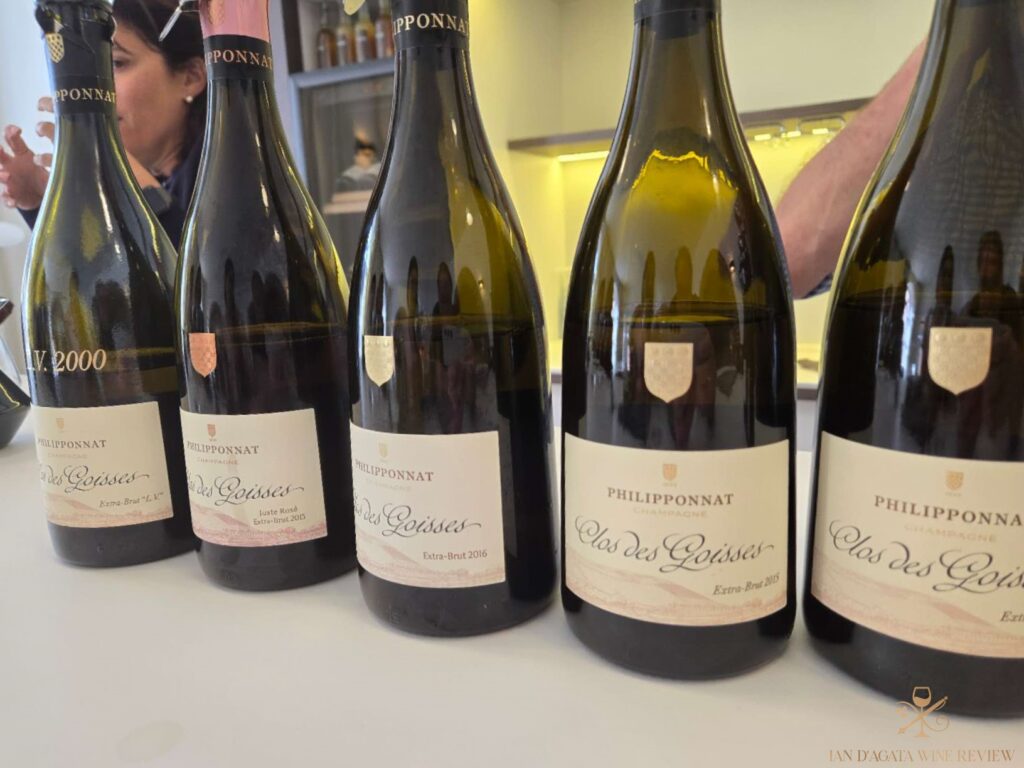by Ian D’Agata
Philipponnat is one of Champagne’s most venerable houses, and its prestige cuvée, the world-famous Clos des Goisses, is arguably one of the top five or six Pinot Noir and Chardonnay blends of Champagne. It is a magical bubbly that is the object of desire of collectors and everyday wine lovers alike. Philipponnat, generally viewed as a Pinot Noir specialist, makes about 60,000 cases of wine a year, divided amongst as many as thirteen different cuvées, but it’s their Clos des Goisses that is undoubtedly the object of desire of wine lovers everywhere. The winery is now part of the Lanson-BCC portfolio of eight Champagne houses, but since 1999 it has been managed once again by a member of the Philipponnat family, the soft-spoken but extremely likeable and talented Charles Philipponnat. He is both Philipponnat’s top manager and chief winemaker (his father was chef de cave of Dom Perignon for thirty years).
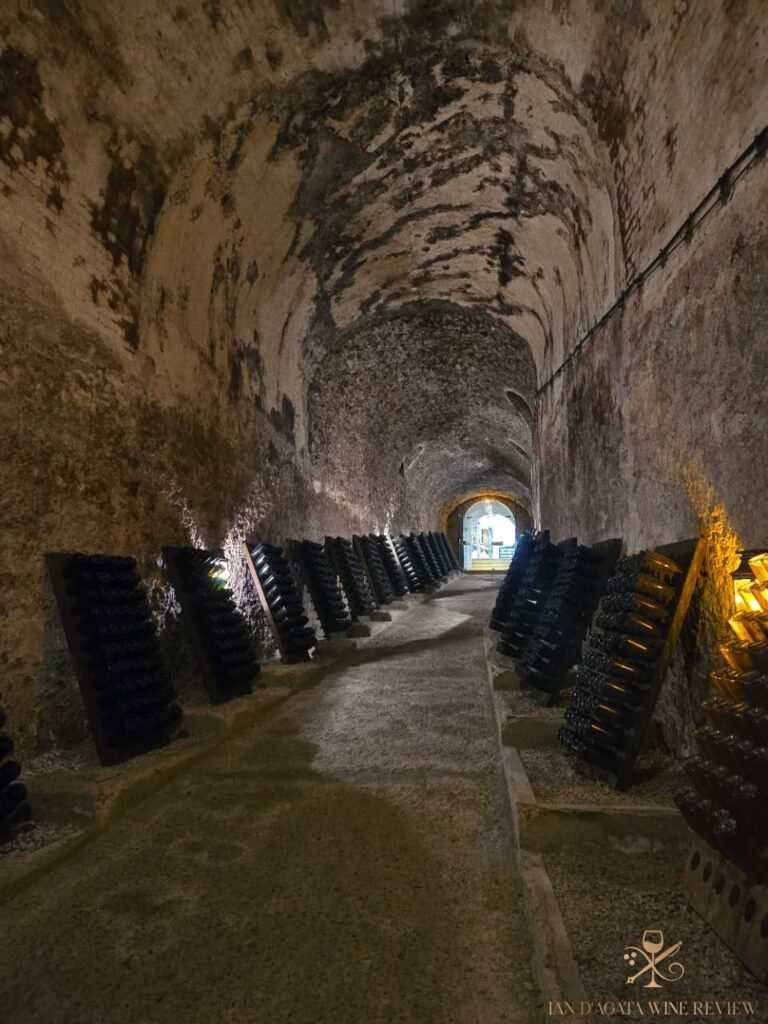
Located in the quiet village of Mareuil-sur-Aÿ in the Vallée de la Marne, Philipponnat was founded in 1522: in that year, Apvril le Philipponnat (that, by the way, is not a typo, but an accurate spelling of his name), owned vines between Aÿ and Dizy in an area called Le Léon. (It therefore cannot surprise that one of Philipponnat best modern-day Champagnes has been named Le Léon too.) The Clos des Goisses started life a little later, in 1935, when Pierre Philipponnat (the great uncle of Charles Philipponnat), the founder of the modern-day Philipponnat Champagne house, began to buy vines within a walled area that was later to become the Clos de Goisses. He didn’t know it at the time, but by bottling the product of this specific site’s vines, Pierre launched the region’s first-ever Clos Champagne. There are other Clos Chmapagnes today (eleven, at last count), and some are very famous; but it’s Clos des Goisses that was the first. And although the exact birthdate of the first Clos des Goisses Champagne by Philipponnat is not known (the original owners of the property made just a “vin des Goisses” or “Les Goisses” wine), it is believed to be 1947, though the bubbly became officially known as the “Clos des Goisses” wines about a decade later.

Clos des Goisses, the vineyard
All told, the Philipponnat winery owns about eighteen hectares of vines and farms another two under a sharecropping agreement, all of which are located in Mareuil-sur-Aÿ, Aÿ, Avenay Val d’Or and Mutigny. The majority of the domaine’s vineyards are located in the territory of the first of those towns, and that is where you find the magnificent Clos de Goisses, as mentioned the oldest clos vineyard in Champagne.
Sixteenth century local maps and engravings document that the specific slope where the Clos is located (in the historic heart of Champagne) was always associated to vines and a very famous, much sought-after wine. However, the Clos de Goisses vineyard’s layout of today differs from that of centuries ago. The vineyard now spans an area running from Cumières to Bisseuil, but it was once much smaller. The house of Philipponnat deserves much credit for having brought the site back to life, for by the beginning of the twentieth century, much of what is today a monopole site had been abandoned. This was because of how very hard the Clos des Goisses site was to work (it has an extremely steep gradient) and because phylloxera had killed off most of the vines. And so, it took decades to develop and grow the Clos into what it is and represents today.
Pierre Philipponnat bought the first 2.54 hectares of vines in the Clos in 1935, and then continued to buy more and more vines there. He was well aware of just how outstanding the site was for quality grape-growing: the fact it was owned by his cousins, the Bouché family, probably gave him some insight into the matter, but still: lady luck may be blind, but skill and talent usually see very well indeed. His cousins made a Champagne Bouché (the Bouché family still exists: apparently, some of its members are shareholders of Billecart-Salmon). It was they who first made a wine called “Les Goisses” or “Vin des Goisses” (perhaps even “La Goisse”), most likely from the 1880s until the 1930s. But the difficult economic times brought on by the devastation caused by phylloxera and two World Wars led to the Societé Génerale du Champagne of the Bouché family going out of business. The Philipponnats bought the property, and so became the first family in Champagne to produce, bottle, and sell a clos Champagne, at first simply called Les Goisses. The name of “Clos des Goisses” appears on a wine label for the first time by the end of the 1950s (either in 1956, 1957, 1958, or 1959, but there is no documentation of which one of those it might be). For sure, it was a French journalist who, after visiting the winery in 1956, wrote an article in which he first mentioned the word “Clos” (upon seeing the iron grid fence surrounding houses and vines and reminiscing of Burgundian days and nights), which led to the name of the wine being changed to “Clos de Goisses”.
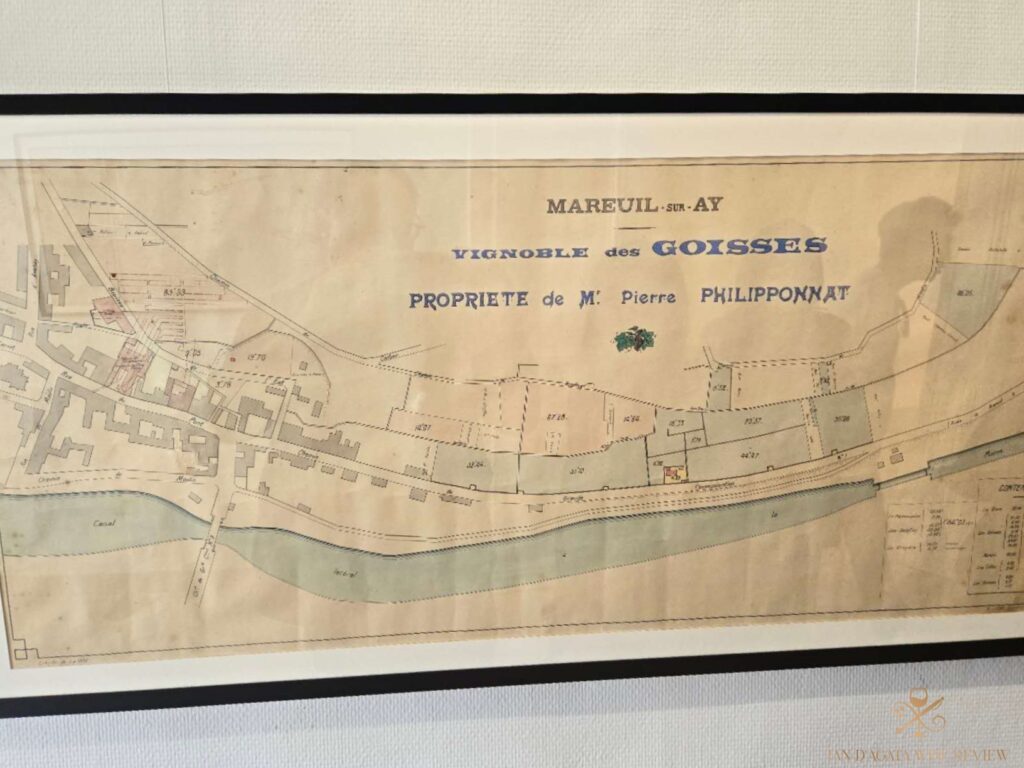
In fact, the vineyard and its wine could not have been called a “Clos” beforehand, because the vineyard was not entirely closed off by walls (a clos in French refers to a walled, fenced-in, vineyard). The Bouché family had built walls that partly surrounded the vines already back in the 1860s (the cintres, where the word cintre means “arch” and refers to the arched brick walls that surround the vineyard), but it was Pierre Philipponnat who closed off the vineyard entirely. Thanks to him, the drystone wall running parallel to the canal at the bottom of the slope and the wall at the top were added, effectively turning the vineyard into a true clos. Actually, if one must be really accurate about this, the wall at the bottom is more of a retaining wall (and a very necessary one, given that the vineyard’s steep slope would otherwise have soil and rocks tumbling down from above all the time), but doesn’t really fence the vines in. That much recognized, I for one won’t quibble. The Clos des Goisses is far too magnificent to let a little thing like a name get in the way of its greatness.
From the original 2.54 hectares bought by Philipponnat, the Clos des Goisses has expanded in size to its current 5.83 hectares, and in so doing has finally become a Philipponnat monopole. Despite most websites and magazine articles stating the vineyard is 5.5 hectares large, it increased to its present size in 2019 when Charles Philipponnat, in an exchange of vineyard parcels with two other growers, received the couple of plots (located in the slightly flatter section at the top of the Clos) still missing from the winery’s holdings, enabling Philipponnat to complete full ownership of the site and call the Clos des Goisses a monopole. The first of these exchanges took place in 2016, landing a plot (0.43 hectares) at the corner towards the east side; then, about four years ago it was the turn of the Sous la carrière plot, which they got by exchanging with their La Croix Blanche, a fine site but outside of the Clos. And this is why today the size of the Clos des Goisses is now 5.83 hectares instead of the 5.4-5.5 hectares reported most everywhere else.
I hear you ask: but what makes the Clos des Goisses such a special vineyard site?
The Clos des Goisses is subdivided into fourteen different plots, identified by stone markers bearing the name of each specific vineyard plot area and placed at the entry points of each plot. The grapes from each of these fourteen plots will give a slightly different Champagne, and it is their blend that allows to make the best possible Clos des Goisses Champagne every vintage; importantly, not all of the fourteen plots are used to make the finished wine every year, meaning that some Clos des Goisses grapes are “declassified” into the other Philipponnat Champagnes in practically every year. Which plots give the best wines every year depends on the vintage’s growing season; but generally speaking, some of the areas on top of the hill, where the Clos’s topography flattens out, often give less interesting grapes and wines. This is especially true of a section to the east where a rather productive Pinot Noir clone had been planted. Charles Philipponnat told me they were thinking of over-grafting those vines with some Chardonnay, as they think they might need more of that grape variety in the future as a result of the advent of climate change.
From the road below, the Clos des Goisses vineyard can be admired as a very steep slope (it has a thirty to forty-five degrees incline), overlooking a canal that flows lazily below. It is not just one of Champagne’s most beautiful vineyards, it is also its hottest. The steep gradient (in fact believed to be the steepest of any major vineyard in Champagne) gives this prestige cuvée its name: in the old Champenois dialect, the word gois (or goisse, which is the feminine singular of gois) means “inclined” or “slanted”; but in every day local Champenois life, the term is used to refer to a “very steep slope”. The combination of that gradient, plus the fact that the vines are exposed full south, results in the Clos des Goisses being Champagne’s vineyard with the highest average daily temperatures. It has a very warm to hot microclimate (on average, temperature values in the Clos des Goisses are 1.5-2 degrees Celsius higher than the regional average). It follows, and this is important, that the grapes of the Clos des Goisses are usually so ripe that chaptalization is never necessary to make the wine, a practice that is instead quite common in the rest of the Champagne region. In fact, the topography of the Clos des Goisses vineyard follows a slight curve: its middle part is where the topsoil is thinnest but also where the solar radiation from the sun hits the soil at its most perpendicular angle, leading to an exceptionally powerful, deep expression of the Clos des Goisses grapes from this specific section of the vineyard.
But topography and microclimate are not the only reason behind the uniqueness of the Clos des Goisses and its wine. It is also a matter of a very characteristic soil and subsoil, a pure Belemnite chalk bedrock high in active lime (30%) surmounted by a thin layer (fifteen to twenty-five centimeters, at most) of nutrient-poor surface topsoil known as a rendzina or rendsina, a chalky debris that is powdery-like and mixed with sparse organic matter. (Clearly, the topsoil cannot be very deep in the Clos, given the constant erosion it is subjected to by way of its gradient.) The geology of the Clos des Goisses is important, because the soil/subsoil complex accumulates daytime heat, ensuring full and optimal grape ripeness; but the presence of limestone in the soil-subsoil complex is also important, as it gives the finished wine noteworthy amounts of citrussy acidity, providing considerable freshness (even in these times of climate change) to what is an undeniably powerful Champagne.
Last but not least, it is worth knowing than in select, few, vintages, Philipponnat will also make a Champagne called “Les Cintres”, an Extra Brut Champagne with grapes sourced from two specific plots within the Clos des Goisses vineyard. The two plots that are at the core of the greatness of Clos des Goisses (and that will end up in Les Cintres more often than not, when it is made), are called Les Grands Cintres and the Les Petits Cintres, situated in the most central and steepest part of the Clos, where the site’s oldest vines grow. Again, it is rare that the grapes of all fourteen plots of the Clos go into a specific vintage’s Clos des Goisses Champagne: depending on the vintage’s growing season characteristics, more or less of the grapes from the Clos will be used to produce that year’s Champagne Clos des Goisses. For example, the 2011 Champagne Clos des Goisses is made with grapes picked in only four of the fourteen plots; by contrast, in 2010, it was five plots.
Clos de Goisses, the Champagne
Clos des Goisses was the first Champagne prestige cuvée to be sold through La Place de Bordeaux (a network that sells most of Bordeaux’s famous wines and other important wines from all over the world to international markets). That is yet another distinguishing factor of this great prestige cuvée that, as we have seen, seems to collect “firsts”. Classically, Clos des Goisses Champagne has always been a mostly Pinot Noir bubbly that spends at least eight years on the lees. Before Charles Philipponnat’s arrival at the helm, the blend of the finished wine hovered around 67 percent Pinot Noir and 33 percent Chardonnay, but is now closer to 75/25 in favour of the Pinot Noir. Pinot Meunier is no longer used, as Charles removed it from the blend upon his arrival. Instead, he has looked to progressively increase the presence of Pinot Noir, wanting to bring it back to the highly dominant role it once had in the Clos des Goisses wine. For example, from 1913 to 1962, when the chef de cave/winemaker at Philipponnat was Louis Boland (a pharmacist and biologist by training who was one of the first consultant winemakers in the region, as well as the inventor of a bentonite-alginate riddling agent called colle Bolland), Clos de Goisses was famously a mostly Pinot Noir Champagne. Seeing how the Clos de Goisses was always known to be a warm site, it can hardly surprise that its Pinot Noir was always considered of high quality (even more so decades ago, in climate-challenged, cooler, times when the Champagne region’s Pinot Noir practically never reached optimal ripeness).
At Philipponnat, the goal is to make powerful wines but that are also fresh and age well; the Maison’s goal is not to produce oxidative-styled wines. The soil of the Clos also helps this be just so. Because of a higher percentage of chalk and limestone in the soil, the Clos des Goisses is a Champagne that though powerful, is much more graceful in style than, for example, the rich, full-bodied Pinot Noir-based bubblies made with the Pinot Noir of Ambonnay and Bouzy (where there tends to be more soil clay and loam, but less chalk). These different sources of Pinot Noir give different wines, each with its strengths and particularities, and each with its adoring legions of fans. In ultimate analysis, it’s your palate that will determine which you end up liking more.
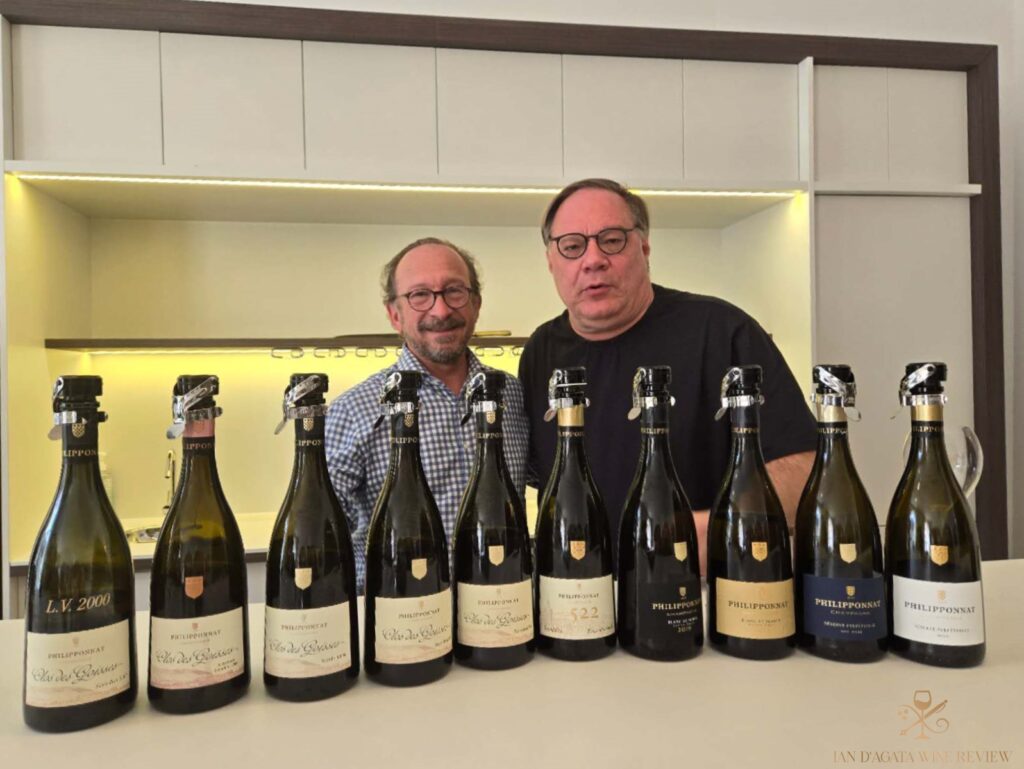
Clearly, in as cold a region as is Champagne, Pinot Noir rarely reaches full physiologic ripeness, and this is still true even in this day and age of climate change. This is exactly why Pinot Noir always needed to be destemmed in Champagne, because the variety’s stems rarely if ever reached acceptable ripeness levels. Not only that, but it used to be that Pinot Noir-dominated Champagnes almost always oxidised precociously, and tasted too heavy and coarse. Relative to the problems with oxidation, Charles Philipponnat decided to re-introduce oak vinification at the winery, counting on the anti-oxidant capacities of the tannins in wood. It was he who brought back the use of barriques (228 liters) in which to partially ferment the Clos de Goisses wine. Traditionally, the Clos de Goisses wine was fermented in stainless steel tanks or old large foudres, but barriques have now been used since 2000, such that today as much as 40-50% of Clos de Goisses Champagne can be/is barrique-fermented. Similarly, the potential rusticity of some Pinot Noir wines from Champagne was counterbalanced by the addition of a little, and later more and more, Chardonnay to the blend, as a way of ensuring greater freshness and lightness of being. What can I say, Milan Kundera is probably beaming somewhere up there right now.
In cooler, higher-acid vintages like 1996 and 2008, the percentage of Chardonnay in the Clos des Goisses Champagne blend is increased by blending in the best first press Chardonnay wine from grapes grown in the Clos. It follows that the Clos des Goisses blend can change from vintage to vintage, though it remains a mostly Pinot Noir-dominated Champagne. To date, the 2011 remains the only Clos des Goisses that is 100% Pinot Noir (because at Philipponnat they didn’t like their Chardonnay much that year, mostly as a result of an oidium outbreak, but they had also uprooted much of their Chardonnay just before this vintage and needed to wait to replant). Interestingly, and for what it’s worth, the 2011 has always been my least favourite Clos des Goisses of all.
Freshness and refinement in Clos des Goisses Champagne are also achieved by avoiding malolactic transformation; this allows the wine’s natural acidity to ensure freshness. The quest for freshness is also why Clos des Goisses is now an Extra Brut Champagne (it was a Brut up until the 1990s), finished with very little dosage (roughly 4 g/L of residual sugar).
Last but not least, Philipponnat also releases special bottlings of Clos des Goisses, the Long Viellissement (“long aged”) Champagnes that have been aged for 25 years in their cold cellars and disgorged six months before going on sale, in a manner similar to Bollinger’s RD [récemment dégorgé (or recently disgorged) and Jacquesson’s DT (dégorgement tardive)].
At the end of the day, what really stands out is that Philipponnat is making some of its best wines ever, and every sip of a Clos des Goisses Champagne will remind you of just that.
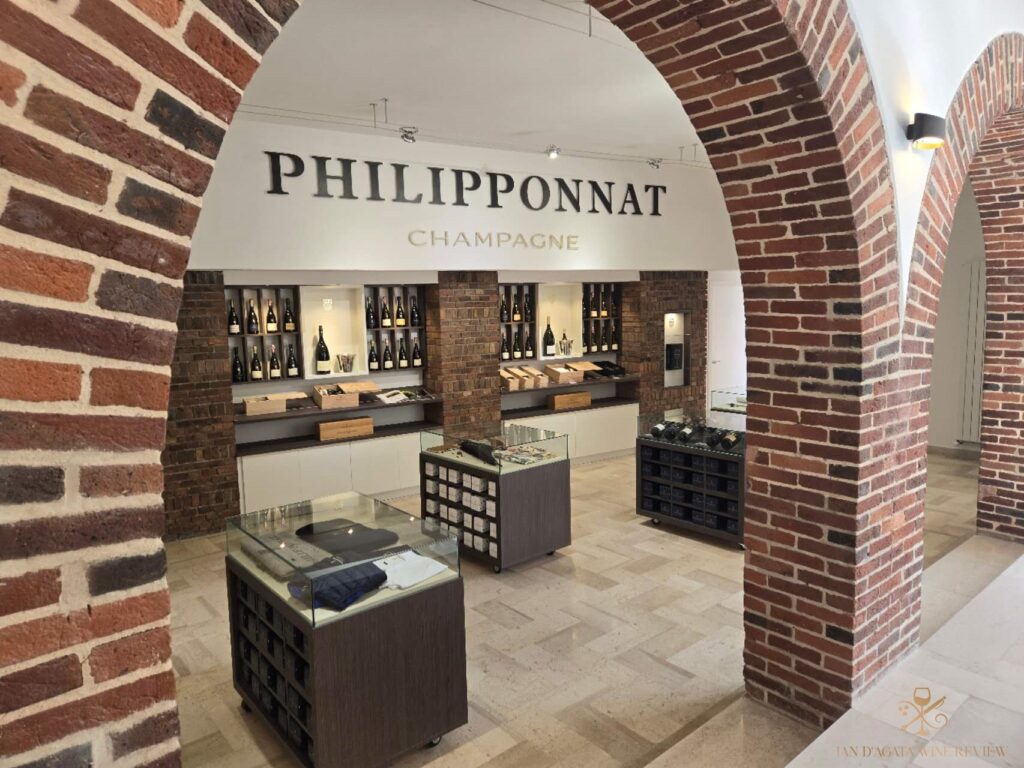
The wines in this report
Over the years, I have written about Clos des Goisses and various old vintages; the wines in this report were tasted all in 2025 [partly in Shanghai (March and June), Rome (April), and directly at the winery in the presence of Charles Philipponnat (August)].
